The railfan bug hit me at the age of 13. Like
most teenagers, I was short of cash, but managed to scrape
together
enough cash for a Kodak Tele-Instamatic 110 camera. I shot 110
slide film during 1977 and 1978, mostly because
it was cheaper. Kodak 110 "slide film" was actually
reshot by Kodak onto 35mm square Ektachrome, so the
resolution and longevity was pretty good. In 1979, I was making
enough money to buy print film, a move I now
regret, since the negatives are almost completely gone.
Growing up in Grand Rapids, I mostly shot the locals and time
freights as they passed the depot, but sometimes the
Line-up would add variety, such as work trains, weed sprayers,
track geometry cars, Soo Line detours, Milwaukee
Road SD40-2s on coal trains, and an occasional passenger train.
But my interest was in the ore trains, whose path was a few miles
to the east of town, running down the Kelly Lake
line and heading east at Gunn. Getting shots of the ore and
taconite trains required some transportation ingenuity, either
biking along some fairly busy highways, or walking the three
miles east along the tracks from Grand Rapids to Gunn.
Fortunately, my parents sometimes relented, and I was given a
ride to exotic locations like Bovey or Canisteo. Luckily
I had managed to get to know all of the train order operators at
Grand Rapids, to the point where the agent hired me
during the summer of 1978. The job granted me access to the train
Line-ups and to the COMPASS computer tracking
system, both of which were useful in researching the operations
of the ore and tac trains.
I continued taking pictures of trains until 1981, when school and
work pressures forced me to put all of my railfan stuff
and these slides into a box, lost and forgotten until recently.
When railfans think of the Mesabi Iron Range in
Northern Minnesota, this is the image: DM&IR
SD9s, on rust colored ties and surrounded by
wild berry patches.
Shown here is the 116, resting on the wye north
of the Bovey Hi-Grade yard. |
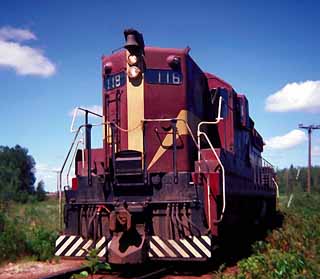 |
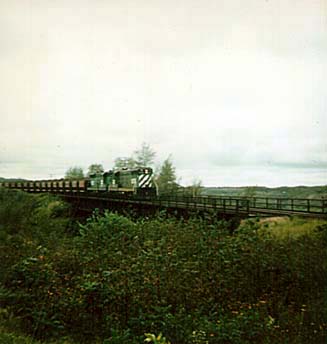 |
Many of the last active mines on the Western Mesabi
were owned and operated by the Hill Group, as in
James J. Hill, founder of the Great Northern. As a
result, the GN, and later Burlington Northern, had a
major presence. Here, SD7 6018 and SD9 6102
operate a mine transfer run from Canisteo to Calumet
in 1978. Natural ore mining ended a few years later. |
The engineer throttles up for a short grade, as the
transfer run rolls through Bovey. Note the mountains
of mine tailings in the background. The 24' ore cars
made a distinct "tink tink tink" sound as their
short
wheelbase impacted jointed rail. |
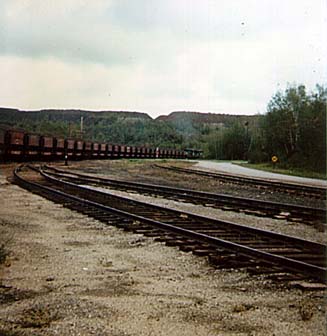 |
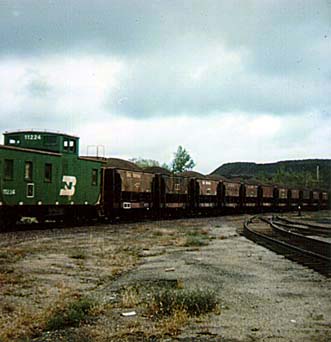 |
The last of the 40 car cut passes by, trailed by
wood sheathed caboose BN 11224. Wood
cabooses were commonly used on the mine transfers
including several still in GN red, throughout the 1970s. |
Southwest of Bovey, the Canisteo mine spur and
marshalling yard played host to a small depot. Since
mine runs (and an occasional dock train) turned
here, a train order operator was required during the
summer months, usually a single trick low on the
seniority board. Visible in the background is a cut of
empty cars. The low signal at right is a spring switch
indicator. |
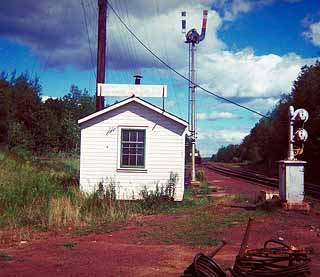 |
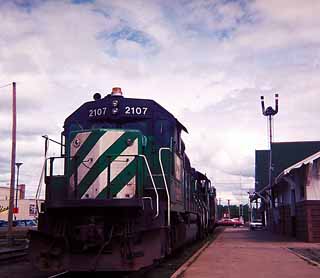 |
Grand Rapids is the formal western end of the
Mesabi Iron Range. Since the ore trains operated
to the east of town, their presence was very rare.
These GP38-2s plus caboose belong to an ore
extra whose crew "died on the line", leaving
their
train at Gunn.
GP38-2s were standard power for ore and taconite
road trains from the early 1970s through the mid
1980s. Note the reddish ore stains on the lower
skirts, a sign that the BN 2107 has made many runs
around the loop. |
Time freight 127, with F9 832 in the lead, arrives
during the eary morning hours in Grand Rapids. The
former NP passenger units were common on this run
between Superior, WI and Devils Lake, ND. Just
try to imagine the chant of 567Cs and a three chime
Nathan echoing off of the Mississippi River bluffs.
Note the ore cars immediately behind the engine. Old
ore cars were commonly used to transport gravel. |
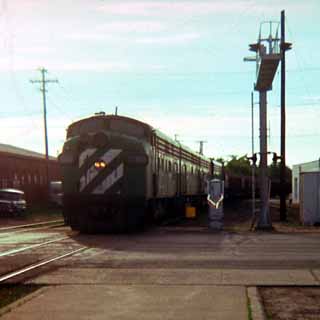 |
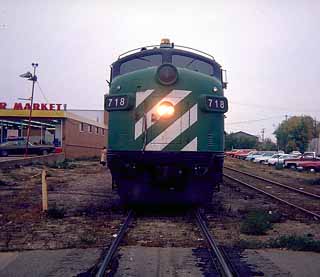 |
Two passenger specials visited Grand Rapids during
the late 1970s. The first was sponsored by an
historical society in Duluth, and later, a stockholder's
special. BN F7 718 was the lead unit on the stock
holder extra, which ran from Superior to Grand
Rapids, and was turned on the wye at MP&L in
Cohasset. |
| The former NP observation car Kootenai River. |
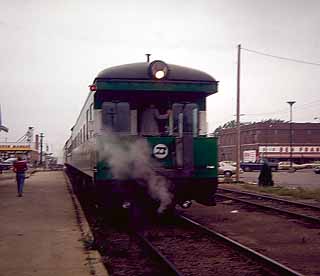 |
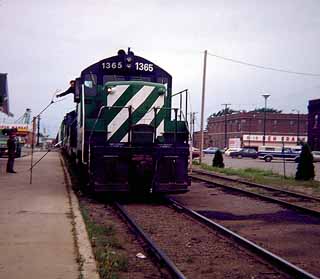 |
Grand Rapids hosted three locals, originating from
Cass Lake, Deer River, and Superior. Shown here
is the Superior Local, on the way back home. The
lead unit is ex-GN GP5 1365, my personal
favorite. Rebuilt from a GN FT-B unit, the 1365
rolled off a dock into Lake Superior in 1973, and
received a chopnose while it was being rebuilt. The
unit was rebuilt again in 1994 as the 1520, which is
now running around with some 50+ year old parts.
The Extra 1365 East is picking up train orders and
a Clearance Form A. The man on the platform is the
first trick train order operator, Eugene Laliberte. |
Two old bulldogs of the rails. On the right is BN
710,
a former SP&S passenger F3-A, over 30 years old.
On the left is third trick operator Daniel Jones, well
beyond 30 years old. Dan was my mentor, and taught
me most of the basics of being a train order operator:
copying the orders, stringing the forks, pulling the
boards, rollby inspection (shown here), and hacking on
the often tempermental IBM COMPASS equipment.
The Extra 710 East, time freight #128, passes through
Grand Rapids at the 12 mph pace dictated by the
City Fathers.
|
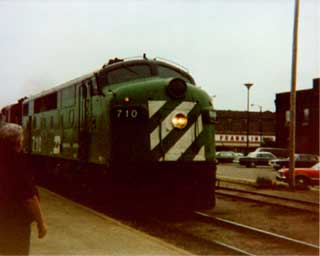 |
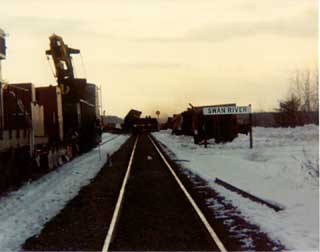 |
In December of 1979, an all-rail taconite train
went on the ground at Swan River, about 20 miles to the
east of Grand Rapids. Fortunately, my older brother
now had a driver's license, and we were able to take
the truck to the scene. The cause of the accident was
a rail which broke under the middle of the train, causing
a break-in-two, a pileup of ore cars, pellets everywhere,
and a pretty rough ride for the guys in the caboose.
|











